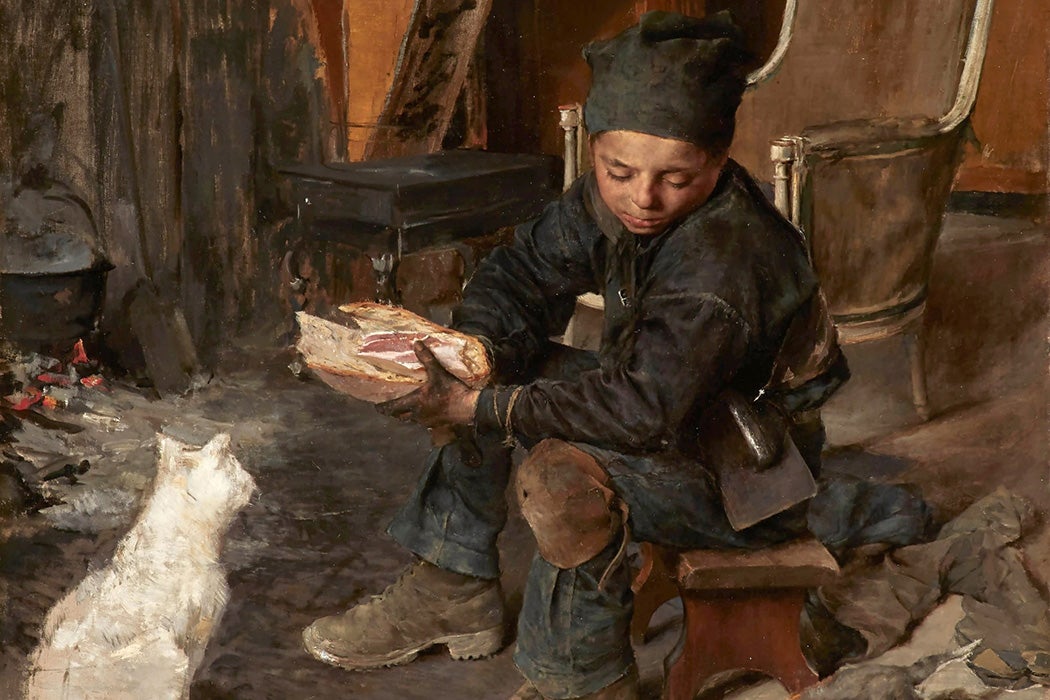The brutal murder of nine-year-old-apprentice chimney sweep Patrick Usher didn’t cause much public stir in Dublin in 1777. “Climbing boys” like Usher were bruised, broken, burned, and killed regularly in their work in narrow, hot brick chimneys. And outside the flues, their poor treatment by their masters was taken for granted.
What was unusual about the case was that James Murphy, Usher’s master, was executed for the crime. Murphy had plenty of reason to think he’d not be found guilty; historian James Kelly writes that “society at large chose to overlook the abuses that were an inevitable consequence” of the necessity of chimney-sweeping. Most people were “largely accepting of the child injuries and, on occasion, child fatalities that were a feature of the trade.”
But the extended tortures and beating to death of young Usher made for such an extreme case that authorities intervened. A new age was dawning, although it would still take quite a while to get past the reluctance of chimney cleaning professionals and the homeowners who hired them to end the exploitation of soot-covered boys. Yet slowly through the late eighteenth and early nineteenth century, what had been acceptable became unacceptable. The regulation, enforcement of those regulations, and then the outlawing of child sweeps in the second half of the nineteenth century tracked the turn against child labor as a whole.
Climbing boys, and they were almost always boys, could be as young as five. They were more typically between seven and ten, until the Chimney Sweepers Act of 1788 raised the minimum age to eight (though it was little enforced). The boys were exploited precisely for their youth and/or small size. The job was filthy and extremely hazardous. They could be roasted to death. Non-fatal injuries included burns, swollen knees, reduced vision, stooped backs, and “sweep’s cancer” or “soot wart”—a carcinoma of the skin of the scrotum. Some of the children were undoubtedly sold into the trade by their parent(s), but most were formally apprenticed, like Patrick Usher. Lord Shaftesbury in 1875 called them “most oppressed, degraded, and tortured creatures on the face of the earth.”
Child chimney sweeps virtually tumble out of the literature (Blake, Dickens, Kingsley, Lamb…), leaving a trail of soot, broken bones, and not a little sentimentalization. Dickens in particular wrote about them frequently. Oliver Twist has a whole chapter dedicated to them. As a middle-class social reformer, Dickens exposed the horrors of their condition, while, as a middle-class entertainer, he thrilled his readers with their picturesque and colorful characters.
London, the largest Western city of the day, was the epicenter of the trade, with contemporary estimates of some 500–600 climbing boys in the metropolis in the 1780s. Kelly notes that there were no similar contemporary statistics for Ireland, but based on the London numbers he suggest eighty to ninety of them working in Dublin in this period.
“[B]rick-lined chimneys that are as emblematical of the era as fanlights and stuccoed ceilings required regular cleaning if the aggregation of soot that was the inevitable consequence of the dependence on coal, turf and wood was not to become a fire hazard and the number of climbing boys grew in response,” Kelly writes.
Weekly Newsletter
In 1803, the Society for Superseding the Necessity of Climbing Boys was formed in London to encourage mechanical methods of cleaning chimneys and focus the “combination of evangelicals and philanthropic-minded” who rallied to the chimney sweeps’ cause. Branches of the SSNCB would be established in Ireland in the late 1820s, roused by two scandalous cases of child-stealing by master sweeps in Dublin. Ever more voices for the abolition of the practice were raised, and a succession of laws to reform and regulate the industry were enacted in 1828, 1834, 1840, and 1864. But it wasn’t until 1875 that the Irish constabulary was committed to enforce the prohibition on chimney sweepers under twenty-one.
“The incremental inauguration of a prohibition on the employment of children as chimney sweeps was a step on the road to the acceptance of the argument that adults should not be at liberty to recruit children to undertake work that was injurious to their health and well-being,” Kelly concludes.







